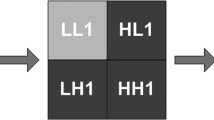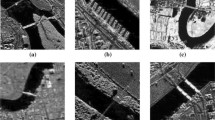Abstract
In this paper, a parallel region merging strategy is proposed for partitioning Synthetic Aperture Radar (SAR) images into several disjoint regions, based on the region adjacency graph (RAG) of an initial partition and the nearest neighbor graph (NNG) produced from the RAG. Developed from the multi-direction ratio edge detector, a multi-scale-multi-direction (MSMD) one is used to extract edge strength map (ESM) of an initial SAR image, feeded into watershed transform to generate an initial partition result of the initial SAR image. Considering local image properties, which makes the generated NNG center around bi-node circles situated in interiors of homogeneous regions, many of which are independently located in different homogeneous regions, the predication of the parallelizability for bi-node circles is proposed to make the proposed parallel region merging strategy. The proposed parallel merging strategy simultaneously merges bi-node circles far away from boundaries of regions, characterized by the length of path from a node to the bi-node circle in the NNG. The performance of the proposed parallel merging strategy is analyzed theoretically and experimentally, and our experiments show that the proposed method outweighs other compared methods.






Similar content being viewed by others
References
Akyilmaz E (2018) Multilogit prior-based gamma mixture model for segmentation of sar images. In: IEEE geoscience and remote sensing letters
Arbelaez P, Maire M, Fowlkes C, Malik J (2011) Contour detection and hierarchical image segmentation. IEEE Trans Pattern Anal Mach Intel 33 (5):898–916
Badrinarayanan V, Kendall A, Cipolla R (2017) Segnet: a deep convolutional encoder-decoder architecture for image segmentation. IEEE Trans Pattern Anal Mach Intel 39(12):2481–2495
Calderero F, Marques F (2010) Region merging techniques using information theory statistical measures. IEEE Trans Image Process 19(6):1567–1586
Carvalho EA, Ushizima DM, Medeiros FN, Martins CIO, Marques RC, Oliveira IN (2010) Sar imagery segmentation by statistical region growing and hierarchical merging. Digital Signal Process 20(5):1365–1378
Chan TF, Vese LA (2001) Active contours without edges. IEEE Trans Image Process 10(2):266– 277
Cook R, McConnell I, Oliver CJ, Welbourne E (1994) Mum (merge using moments) segmentation for sar images. In: SAR Data processing for remote sensing, vol 2316, International Society for Optics and Photonics, pp 92–104
Duan Y, Liu F, Jiao L, Zhao P, Zhang L (2017) Sar image segmentation based on convolutional-wavelet neural network and markov random field. Pattern Recogn 64:255–267
Eppstein D, Paterson MS, Yao FF (1997) On nearest-neighbor graphs. Discrete & Computational Geometry 17(3):263–282
Fan S, Sun Y, Shui P (2020) Region-merging method with texture pattern attention for sar image segmentation. IEEE Geoscience and Remote Sensing Letters
Felzenszwalb PF, Huttenlocher DP (2004) Efficient graph-based image segmentation. Int J Comput Vis 59(2):167–181
Fjortoft R, Lopes A, Marthon P, Cubero-Castan E (1998) An optimal multiedge detector for sar image segmentation. IEEE Trans Geosci Remote Sens 36(3):793–802
Galland F, Bertaux N, Réfrégier P (2003) Minimum description length synthetic aperture radar image segmentation. IEEE Trans Image Process 12(9):995–1006
Gao L, Song J, Nie F, Zou F, Sebe N, Shen HT (2016) Graph-without-cut: an ideal graph learning for image segmentation. In: Thirtieth AAAI conference on artificial intelligence
Gao L, Song J, Zhang D, Shen HT (2018) Coarse-to-fine image co-segmentation with intra and inter rank constraints. pp 719–725
Gemme L, Dellepiane SG (2018) An automatic data-driven method for sar image segmentation in sea surface analysis. IEEE Trans Geosci Remote Sens 56 (5):2633–2646
Grunwald PD (2007) The minimum description length principle. MIT Press
Haris K, Efstratiadis SN, Maglaveras N (1998) Watershed-based image segmentation with fast region merging. In: International conference on image processing, IEEE, pp 338–342
Komodakis N, Xiang B, Paragios N (2015) A framework for efficient structured max-margin learning of high-order mrf models. IEEE Trans Pattern Anal Mach Intel 37(7):1425–1441
Lang F, Yang J, Li D, Zhao L, Shi L (2014) Polarimetric sar image segmentation using statistical region merging. IEEE Geosci Remote Sens Lett 11(2):509–513
Lei P, Zheng T, Wang J, Bai X (2020) A joint convolutional neural network for simultaneous despeckling and classification of sar targets. IEEE Geoscience and Remote Sensing Letters
Li BN, Qin J, Wang R, Wang M, Li X (2016) Selective level set segmentation using fuzzy region competition. IEEE Access 4:4777–4788
Li SZ (1994) Markov random field models in computer vision. In: European conference on computer vision, Springer, pp 361–370
Li W, Benie GB, He DC, Wang S, Ziou D, Hugh Q, Gwyn J (1999) Watershed-based hierarchical sar image segmentation. Int J Remote Sens 20(17):3377–3390
Liu Z, Li X, Luo P, Loy CC, Tang X (2018) Deep learning markov random field for semantic segmentation. IEEE Trans Pattern Anal Mach Intel 40(8):1814–1828
Long J, Shelhamer E, Darrell T (2015) Fully convolutional networks for semantic segmentation. pp 3431–3440
Lu Y, Chen Y, Zhao D, Liu B, Lai Z, Chen J (2020) Cnn-g: Convolutional neural network combined with graph for image segmentation with theoretical analysis. IEEE Transactions on Cognitive and Developmental Systems
Luo S, Tong L, Chen Y (2018) A multi-region segmentation method for sar images based on the multi-texture model with level sets. IEEE Trans Image Process 27(5):2560–2574
Marques RCP, Medeiros FN, Nobre JS (2012) Sar image segmentation based on level set approach and \({g_{a}^{0}}\) model. IEEE Trans Pattern Anal Mach Intel 34(10):2046–2057
Nie X, Qiao H, Zhang B (2015) A variational model for polsar data speckle reduction based on the wishart distribution. IEEE Trans Image Process 24(4):1209–1222
Nock R, Nielsen F (2004) Statistical region merging. IEEE Trans Pattern Anal Mach Intel 26(11):1452–1458
Oliver C, Blacknell D, White R (1996) Optimum edge detection in sar. IEE Proceedings-Radar Sonar and Navigation 143(1):31–40
Pan X, Zhou Y, Li F, Zhang C (2017) Superpixels of rgb-d images for indoor scenes based on weighted geodesic driven metric. IEEE Trans Vis Comput Graph 23(10):2342–2356
Panagiotakis C, Grinias I, Tziritas G (2011) Natural image segmentation based on tree equipartition, bayesian flooding and region merging. IEEE Trans Image Process 20(8):2276–2287
Paragios N, Deriche R (2002) Geodesic active regions and level set methods for supervised texture segmentation. Int J Comput Vis 46(3):223–247
Peng B, Zhang L, Zhang D (2011) Automatic image segmentation by dynamic region merging. IEEE Trans Image Process 20(12):3592–3605
Picco M, Palacio G (2011) Unsupervised classification of sar images using markov random fields and \({g_{i}^{0}}\) model. IEEE Geosci Remote Sens Lett 8(2):350–353
Shui PL, Zhang ZJ (2014) Fast sar image segmentation via merging cost with relative common boundary length penalty. IEEE Trans Geosci Remote Sens 52(10):6434–6448
Smits PC, Dellepiane SG (1997) Synthetic aperture radar image segmentation by a detail preserving markov random field approach. IEEE Trans Geosci Remote Sens 35(4):844–857
Touzi R, Lopes A, Bousquet P (1988) A statistical and geometrical edge detector for sar images. IEEE Trans Geosci Remote Sens 26(6):764–773
Wang F, Wu Y, Li M, Zhang P, Zhang Q (2017) Adaptive hybrid conditional random field model for sar image segmentation. IEEE Trans Geosci Remote Sens 55(1):537–550
Xia GS, Liu G, Yang W, Zhang L (2016) Meaningful object segmentation from sar images via a multiscale nonlocal active contour model. IEEE Trans Geosci Remote Sens 54(3):1860–1873
Yang J, Gan Z, Li K, Hou C (2015) Graph-based segmentation for rgb-d data using 3-d geometry enhanced superpixels. IEEE Trans Cybern 45 (5):927–940
Yu F, Koltun V (2015) Multi-scale context aggregation by dilated convolutions. arXiv:1511.07122
Yu H, Zhang X, Wang S, Hou B (2013) Context-based hierarchical unequal merging for sar image segmentation. IEEE Trans Geosci Remote Sens 51 (2):995–1009
Yu Q, Clausi DA (2008) Irgs: Image segmentation using edge penalties and region growing. IEEE Trans Pattern Anal Mach Intel 30(12):2126–2139
Author information
Authors and Affiliations
Corresponding author
Additional information
Publisher’s note
Springer Nature remains neutral with regard to jurisdictional claims in published maps and institutional affiliations.
Rights and permissions
About this article
Cite this article
Zhang, Z., Pan, X., He, K. et al. SAR image segmentation with parallel region merging. Multimed Tools Appl 80, 5701–5721 (2021). https://doi.org/10.1007/s11042-020-09920-4
Received:
Revised:
Accepted:
Published:
Issue Date:
DOI: https://doi.org/10.1007/s11042-020-09920-4




